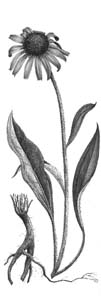Echinacea
By Christina Waters
ONE OF THE PRIMARY medicines among native peoples of North America,
Echinacea angustifolia--purple coneflower-- was used in a favorite
poultice against snakebites, as a cold treatment, and to ease the aches of
arthritis. European settlers in the Midwest quickly adopted echinacea as a
remedy, attracting the attention of the East Coast medical community, which
soon sent samples of the flower and roots to colleagues across the Atlantic.
By the turn of the century, echinacea was a fixture in every medicine cabinet
and enjoyed favor as a cold remedy until the raging debate between
alternative healers and the AMA practitioners sent its use into a steep
decline. Once patent medicines and antibiotics came on the scene after World
War I, echinacea almost disappeared from use in the United States.
Today echinacea enjoys huge sales, largely owing to its widely reported
effectiveness against that most stubborn of maladies--the common cold.
Echinacea seems to be most potent as an extract. Confirmed users report that
if taken at the first sign of a scratchy throat or plugged-up nose, echinacea
can actually prevent a cold from developing.
How it does this occurs in several ways, according to a body of German
studies done over the past several decades. Echinacea not only acts to
prevent infection from invading tissue, but is believed to strengthen the
immune system. Echinacea appears to boost the white blood cells' ability to
kill germs.
Studies also indicate that it can increase levels of infection-fighting
T-cells, and even more important--in terms of possible cancer-fighting
implications--echinacea simulates the infection-fighting abilities of a
hormone called interferon, which is produced by the body. Purists can try
growing their own echinacea, using organically grown seeds packaged by Seeds
of Change.
This
page was designed and created by the Boulevards team.
 The Cold Killer
The Cold Killer
From the January 16-22, 1997 issue of the Sonoma County Independent
Copyright © 1997 Metrosa, Inc.
![[MetroActive Features]](/gifs/feat468.gif)